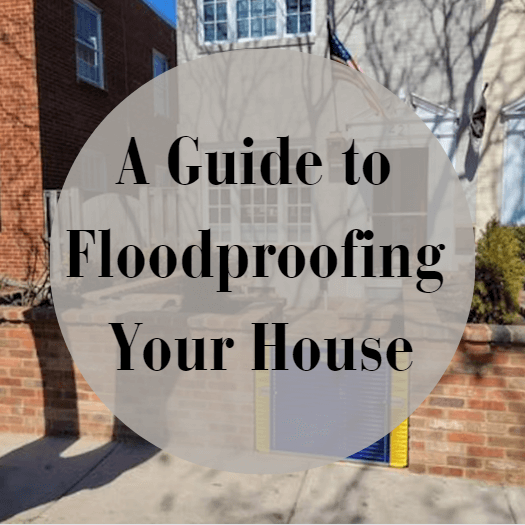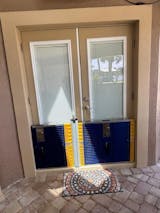Floodproofing a house is important for several reasons, particularly in areas prone to flooding. Here are some key reasons why floodproofing is important:
-
Protection against property damage: Floodwaters can cause significant damage to homes, including structural damage, destruction of personal belongings, and damage to essential systems like electrical and plumbing. Floodproofing measures help minimize or prevent such damage, reducing repair and replacement costs.
-
Preservation of personal belongings: Flooding can destroy sentimental and valuable possessions, such as photographs, documents, and heirlooms. By floodproofing, homeowners can elevate or protect these items, increasing their chances of survival during a flood event.
-
Safety of occupants: Floodwaters pose a significant risk to human safety. They can carry debris, contaminants, and even hazardous materials, making them a potential threat to the health and well-being of occupants. Floodproofing measures such as raising electrical systems, installing flood-resistant barriers, or reinforcing walls can help create a safer environment during a flood.
-
Insurance requirements: In flood-prone areas, insurance companies often require homeowners to implement floodproofing measures to mitigate the risk of damage. Complying with these requirements ensures that homeowners have access to flood insurance coverage and helps maintain the financial stability of the property.
-
Long-term cost savings: While floodproofing initially involves some investment, it can lead to long-term cost savings. By reducing the likelihood and severity of flood damage, homeowners can avoid expensive repairs, increased insurance premiums, and potential displacement from their homes.
-
Community resilience: Widespread floodproofing efforts in a community can contribute to overall resilience against floods. When individual homes are protected, the burden on emergency responders and public infrastructure decreases, enabling resources to be allocated more effectively during flood events.
-
Environmental impact: Flooding can have detrimental effects on the environment, including soil erosion, water pollution, and damage to ecosystems. Floodproofing measures that limit the entry of floodwater into homes also reduce the release of harmful substances, sewage, and chemicals, mitigating the environmental impact of floods.
In summary, floodproofing is essential to protect homes, belongings, and occupants from the damaging effects of floods. It promotes safety, reduces financial burdens, and contributes to the overall resilience of individuals and communities in flood-prone areas.

What happens if you don't floodproof your house?
If you neglect floodproofing a house in an area prone to flooding, several consequences can occur:
-
Property damage: Floodwaters can cause extensive damage to your house and its contents. The water can seep into the structure, leading to structural instability, rot, and mold growth. Flooring, walls, and insulation may need to be replaced, and valuable belongings could be ruined. Without floodproofing measures, your property is more vulnerable to these damages.
-
Safety risks: Flooding poses significant risks to the safety of occupants. As water levels rise, there is a higher chance of electrocution from exposed electrical wiring. Floodwaters can also carry hazardous materials, sharp debris, and contaminants, increasing the risk of injury or infection. Without floodproofing measures, you and your family could be exposed to these hazards.
-
Health hazards: Floodwaters can introduce harmful substances, bacteria, and pathogens into your home. Standing water can become a breeding ground for mold and mildew, leading to respiratory issues and allergies. These health hazards can persist long after the floodwaters recede, affecting the well-being of residents if proper floodproofing measures are not in place.
-
Financial burden: Without floodproofing, you may face significant financial burdens. Repairing and replacing damaged structures, systems, and personal belongings can be costly. In addition, if you don't have flood insurance, you may be solely responsible for covering these expenses. Flood damage can be financially devastating, particularly if you are unprepared for such events.
-
Displacement and disruption: Flooding can force you to evacuate your home temporarily or even permanently, depending on the severity of the flood. Being displaced from your home disrupts your daily life, potentially leading to additional expenses for alternative accommodations. It can also cause emotional distress and upheaval for you and your family.
-
Insurance complications: If you don't floodproof your house, insurance companies may consider it a higher risk property. As a result, obtaining flood insurance coverage can be challenging or more expensive. Without adequate insurance, you may not receive compensation for flood-related damages, further increasing your financial burden.
-
Negative impact on the community: Failure to floodproof your house can have a broader impact on the community. Flooding affects not only individual homeowners but also the surrounding infrastructure and resources. By not taking steps to protect your property, you contribute to the strain on emergency services, public utilities, and the overall resilience of the community during flood events.
It's important to recognize that floodproofing your house is a proactive measure to mitigate these risks and minimize the potential consequences associated with flooding a house.

How do I know if I need to floodproof my house?
The need for floodproofing a house depends on several factors, including your geographical location, proximity to bodies of water, historical flood data, and local regulations. Here are some steps you can take to assess the need for floodproofing:
-
Research flood risk in your area: Begin by understanding the flood risk in your region. Consult flood maps provided by government agencies, such as the Federal Emergency Management Agency (FEMA) in the United States, or local authorities responsible for flood management. These maps indicate flood zones, historical flood data, and the likelihood of different flood events.
-
Evaluate your property's proximity to bodies of water. Assess your property's proximity to rivers, lakes, oceans, or other bodies of water that could potentially cause flooding. Areas near water bodies are generally at higher risk of flooding, but even properties located farther away may still be susceptible to flooding depending on the topography and drainage patterns in your area.
-
Consider local flood history: Research the history of flooding in your region. Are there records of past flood events? How severe were they? This information can give you an idea of the flood risk you may face in the future.
-
Consult with local authorities: Reach out to local government agencies or floodplain management authorities to obtain information about flood risks specific to your area. They can provide guidance on floodproofing requirements, building codes, and regulations that you should follow.
-
Evaluate elevation: Assess the elevation of your property relative to the surrounding area and floodplain. Properties at lower elevations are generally more susceptible to flooding. If your property is located in a low-lying area or below the base flood elevation, floodproofing measures may be necessary.
-
Assess drainage systems: Evaluate the drainage systems in your area. Poor drainage infrastructure or nearby water bodies prone to overflowing can increase the risk of flooding, even in areas not typically considered flood-prone. If your property is susceptible to drainage issues, it may be wise to consider floodproofing a house.
-
Consider past experiences: If you or previous occupants have experienced flooding in your house before, it's a clear indication that floodproofing a house is necessary. Even if the flood event was minor, it's important to take precautions to prevent future damage.
-
Seek professional advice: Consult with professionals such as architects, engineers, or floodplain managers who specialize in flood risk assessment and mitigation. They can provide expert advice tailored to your specific circumstances and help determine the most appropriate floodproofing measures for your house.
Remember, even if you determine that floodproofing is not currently required, it's still prudent to stay informed and be prepared for unexpected changes in flood risk due to factors like climate change or infrastructure development in your area.
The best ways to floodproof a house
There are several effective ways to floodproof a house. The specific methods you choose may depend on your property, your budget, and the level of flood risk you face. Here are some commonly used floodproofing techniques:
-
Elevating the house: Raising the elevation of your house above the base flood level can significantly reduce the risk of flood damage. This can involve raising the entire structure or elevating specific vulnerable components such as electrical systems, HVAC equipment, and appliances. Pilings, stilts, or raised foundations are commonly used for this purpose.
-
Installing flood barriers and barriers: Flood barriers, such as floodwalls or flood panels, can be installed around windows, doors, and other openings to prevent water from entering the house. These barriers are often made of waterproof materials and can be deployed quickly when flooding is anticipated. Floodproof doors and windows with watertight seals are also available for added protection.
-
Waterproofing walls and floors: Applying waterproof coatings or sealants to walls and floors can help prevent water infiltration during floods. These coatings act as a barrier and can be particularly useful in areas where water seepage is a common issue. Additionally, installing water-resistant drywall and insulation can help mitigate flood damage.
-
Improving drainage systems: Adequate drainage around your property is crucial for flood prevention. Ensure that gutters, downspouts, and drainage pipes are properly installed and functioning correctly. Maintain clear and unobstructed drainage paths to direct water away from the house. Consider installing French drains, swales, or rain gardens to divert water and promote proper drainage.
-
Backflow prevention: Install backflow prevention devices on sewer lines and drains to prevent sewage and wastewater from flowing back into your home during flooding. These devices help protect against contamination and minimize damage from sewage backups.
-
Sump pumps: Installing a sump pump in your basement or crawl space can help remove excess water that accumulates during flooding. A sump pump automatically activates when water levels rise, pumping the water out of your house and away from the foundation.
-
Landscape modifications: Landscaping adjustments can help reduce flood risk. Sloping the ground away from the house, creating swales or berms, and using flood-resistant vegetation can improve water runoff and minimize the potential for water accumulation near the property.
-
Proper storage: Store valuable items and important documents in floodproof containers or elevated areas. Consider using shelves or cabinets above the expected flood level to protect your belongings from water damage.
-
Flood insurance: While not a floodproofing measure in itself, obtaining flood insurance is essential for financial protection in the event of a flood. It can help cover repair and replacement costs for flood-damaged property and belongings.
It's important to consult with professionals experienced in floodproofing or local floodplain management authorities to determine the most appropriate floodproofing measures for your specific circumstances. They can provide guidance based on your property's characteristics and the flood risk in your area.
Do you want to know more about modern flood control solutions and ways to floodproof your house? Contact Dam Easy right now and get a special offer on the flood barriers kit designed by experts for your property!
Flood Barrier Door Dam - Ultimate Flood Gate

$949.00
DAM EASY® FLOOD GATE - DOOR DAM Floods are becoming more common around the world. What was once a 100-year phenomenon is now a seasonal trend that homeowners must deal with. That’s EXACTLY why you need this Dam Easy Flood… Read More




















